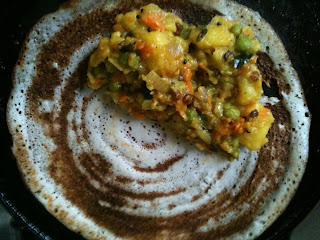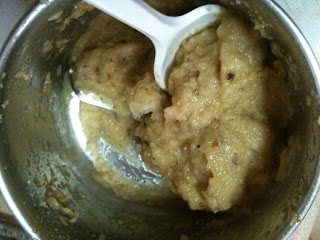Chutney is one kind of spicy sauce that's used as a dip with Indian snacks. Fret not if your stock of coconut or coriander leaves or pudina leaves is low when you want to make a chutney! When I had been to India recently, I watched my mom use carrots and beans to make a chutney. It's very easy to make and it tastes ABSOLUTELY YUMMY! This mixed vegetable chutney goes well with idli, dosai, vadai and you can also use it as a sandwich spread! :)
Difficulty Level - Easiest
Time (All-inclusive) - 10 minutes
Onions - 1 big
Tomatoes - 2 small/medium
One or more of Vegetables like carrots, beans, cauliflower, broccoli, brinjal, etc - 1 cup
Green chillies - 3 nos.
Salt - to taste
Oil - 2 tsp
Mustard seeds - for tadka/tempering
You can spice it up with minced ginger and garlic, but the whole focus of this recipe was to keep it simple and yet, prepare a tasty chutney with as little ingredients as possible. Try it for yourself and let me know how you like it!
This is my entry to Condiment Mela hosted by Srivalli
Difficulty Level - Easiest
Time (All-inclusive) - 10 minutes
What You Need -
Onions - 1 big
Tomatoes - 2 small/medium
One or more of Vegetables like carrots, beans, cauliflower, broccoli, brinjal, etc - 1 cup
Green chillies - 3 nos.
Salt - to taste
Oil - 2 tsp
Mustard seeds - for tadka/tempering
How To -
- Heat 1 tsp oil in a pan, add slit green chillies, cubed onions, tomatoes and vegetables, in that order. Don't bother to chop the veggies fine as we're gonna make it into a paste.
- Add Salt and Fry for about 5 minutes till the raw smell goes away.
- Allow it to cool, then blend to a fine paste adding very little water.
- Temper with mustard seeds.
 |
| Vegetable Chutney |
You can spice it up with minced ginger and garlic, but the whole focus of this recipe was to keep it simple and yet, prepare a tasty chutney with as little ingredients as possible. Try it for yourself and let me know how you like it!
This is my entry to Condiment Mela hosted by Srivalli
















































